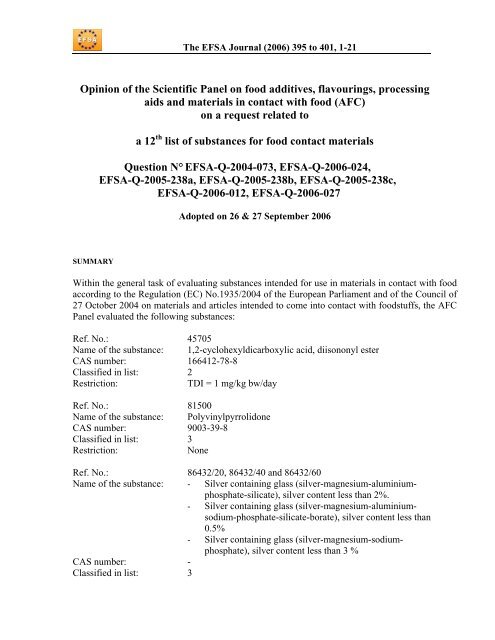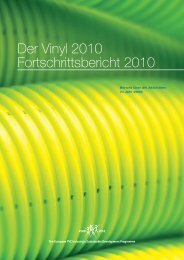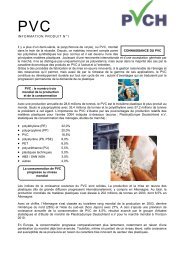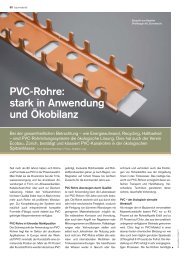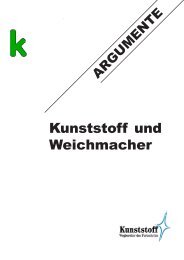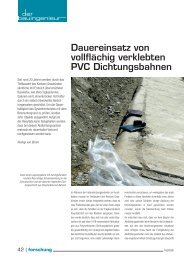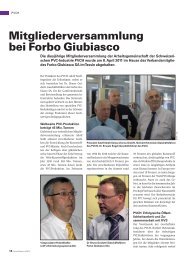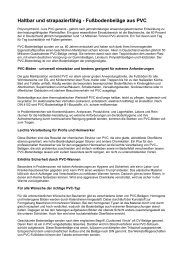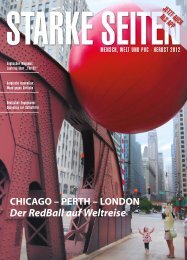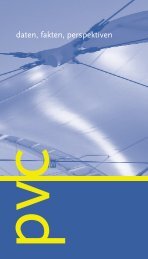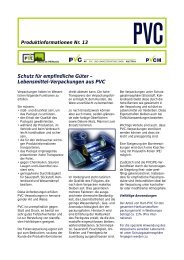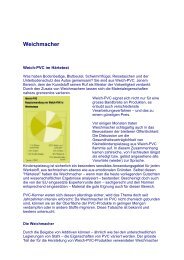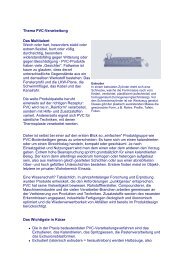Opinion of the Scientific Panel on food additives, flavourings ...
Opinion of the Scientific Panel on food additives, flavourings ...
Opinion of the Scientific Panel on food additives, flavourings ...
You also want an ePaper? Increase the reach of your titles
YUMPU automatically turns print PDFs into web optimized ePapers that Google loves.
The EFSA Journal (2006) 395 to 401, 1-21<br />
<str<strong>on</strong>g>Opini<strong>on</strong></str<strong>on</strong>g> <str<strong>on</strong>g>of</str<strong>on</strong>g> <str<strong>on</strong>g>the</str<strong>on</strong>g> <str<strong>on</strong>g>Scientific</str<strong>on</strong>g> <str<strong>on</strong>g>Panel</str<strong>on</strong>g> <strong>on</strong> <strong>food</strong> <strong>additives</strong>, <strong>flavourings</strong>, processing<br />
aids and materials in c<strong>on</strong>tact with <strong>food</strong> (AFC)<br />
<strong>on</strong> a request related to<br />
a 12 th list <str<strong>on</strong>g>of</str<strong>on</strong>g> substances for <strong>food</strong> c<strong>on</strong>tact materials<br />
Questi<strong>on</strong> N° EFSA-Q-2004-073, EFSA-Q-2006-024,<br />
EFSA-Q-2005-238a, EFSA-Q-2005-238b, EFSA-Q-2005-238c,<br />
EFSA-Q-2006-012, EFSA-Q-2006-027<br />
Adopted <strong>on</strong> 26 & 27 September 2006<br />
SUMMARY<br />
Within <str<strong>on</strong>g>the</str<strong>on</strong>g> general task <str<strong>on</strong>g>of</str<strong>on</strong>g> evaluating substances intended for use in materials in c<strong>on</strong>tact with <strong>food</strong><br />
according to <str<strong>on</strong>g>the</str<strong>on</strong>g> Regulati<strong>on</strong> (EC) No.1935/2004 <str<strong>on</strong>g>of</str<strong>on</strong>g> <str<strong>on</strong>g>the</str<strong>on</strong>g> European Parliament and <str<strong>on</strong>g>of</str<strong>on</strong>g> <str<strong>on</strong>g>the</str<strong>on</strong>g> Council <str<strong>on</strong>g>of</str<strong>on</strong>g><br />
27 October 2004 <strong>on</strong> materials and articles intended to come into c<strong>on</strong>tact with <strong>food</strong>stuffs, <str<strong>on</strong>g>the</str<strong>on</strong>g> AFC<br />
<str<strong>on</strong>g>Panel</str<strong>on</strong>g> evaluated <str<strong>on</strong>g>the</str<strong>on</strong>g> following substances:<br />
Ref. No.: 45705<br />
Name <str<strong>on</strong>g>of</str<strong>on</strong>g> <str<strong>on</strong>g>the</str<strong>on</strong>g> substance: 1,2-cyclohexyldicarboxylic acid, diis<strong>on</strong><strong>on</strong>yl ester<br />
CAS number: 166412-78-8<br />
Classified in list: 2<br />
Restricti<strong>on</strong>:<br />
TDI = 1 mg/kg bw/day<br />
Ref. No.: 81500<br />
Name <str<strong>on</strong>g>of</str<strong>on</strong>g> <str<strong>on</strong>g>the</str<strong>on</strong>g> substance: Polyvinylpyrrolid<strong>on</strong>e<br />
CAS number: 9003-39-8<br />
Classified in list: 3<br />
Restricti<strong>on</strong>:<br />
N<strong>on</strong>e<br />
Ref. No.: 86432/20, 86432/40 and 86432/60<br />
Name <str<strong>on</strong>g>of</str<strong>on</strong>g> <str<strong>on</strong>g>the</str<strong>on</strong>g> substance: - Silver c<strong>on</strong>taining glass (silver-magnesium-aluminiumphosphate-silicate),<br />
silver c<strong>on</strong>tent less than 2%.<br />
- Silver c<strong>on</strong>taining glass (silver-magnesium-aluminiumsodium-phosphate-silicate-borate),<br />
silver c<strong>on</strong>tent less than<br />
0.5%<br />
- Silver c<strong>on</strong>taining glass (silver-magnesium-sodiumphosphate),<br />
silver c<strong>on</strong>tent less than 3 %<br />
CAS number: -<br />
Classified in list: 3
12 th list <str<strong>on</strong>g>of</str<strong>on</strong>g> substances for <strong>food</strong> c<strong>on</strong>tact materials The EFSA Journal (2006) 395 to 401, p. 2 <str<strong>on</strong>g>of</str<strong>on</strong>g> 21<br />
Restricti<strong>on</strong>:<br />
In accordance with o<str<strong>on</strong>g>the</str<strong>on</strong>g>r silver biocides <str<strong>on</strong>g>the</str<strong>on</strong>g>se biocides will be<br />
subject to a group SML <str<strong>on</strong>g>of</str<strong>on</strong>g> 0.05 mg Ag/kg <strong>food</strong><br />
In accordance with o<str<strong>on</strong>g>the</str<strong>on</strong>g>r bor<strong>on</strong> compounds <str<strong>on</strong>g>the</str<strong>on</strong>g> biocide Ref No<br />
86432/40 will be subject to a group SML <str<strong>on</strong>g>of</str<strong>on</strong>g> 6 mg B/kg <strong>food</strong><br />
Ref. No.: 95020<br />
Name <str<strong>on</strong>g>of</str<strong>on</strong>g> <str<strong>on</strong>g>the</str<strong>on</strong>g> substance: 2,2,4-Trimethyl-1,3-pentanediol diisobutyrate<br />
CAS number: 6846-50-0<br />
Classified in list: 3<br />
Restricti<strong>on</strong>:<br />
5 mg/kg <strong>food</strong><br />
Ref. No.: 95420<br />
Name <str<strong>on</strong>g>of</str<strong>on</strong>g> <str<strong>on</strong>g>the</str<strong>on</strong>g> substance: 1,3,5-tris(2,2-dimethylpropanamido)benzene<br />
CAS number: 745070-61-5<br />
Classified in list: 3<br />
Restricti<strong>on</strong>:<br />
0.05 mg/kg <strong>food</strong><br />
KEY WORDS<br />
Food C<strong>on</strong>tact Materials, Plastics, M<strong>on</strong>omers, Additives, REF. No 45705, CAS No 166412-78-<br />
8, 1,2-cyclohexyldicarboxylic acid, diis<strong>on</strong><strong>on</strong>yl ester, REF. No 81500, CAS No 9003-39-8,<br />
Polyvinylpyrrolid<strong>on</strong>e, REF. No 86432/20, Silver c<strong>on</strong>taining glass (silver-magnesiumaluminium-phosphate-silicate),<br />
silver c<strong>on</strong>tent less than 2%, REF. No 86432/40, Silver<br />
c<strong>on</strong>taining glass (silver-magnesium-aluminium-sodium-phosphate-silicate-borate), silver<br />
c<strong>on</strong>tent less than 0.5%, REF. No. 86432/60, Silver c<strong>on</strong>taining glass (silver-magnesiumsodium-phosphate),<br />
silver c<strong>on</strong>tent less than 3 %, REF. No 95020, CAS No 6846-50-0, 2,2,4-<br />
Trimethyl-1,3-pentanediol diisobutyrate, REF. No 95420, CAS No. 745070-61-5, 1,3,5-<br />
tris(2,2-dimethylpropanamido)benzene.<br />
BACKGROUND<br />
Before a substance is authorised to be used in <strong>food</strong> c<strong>on</strong>tact materials and is included in a<br />
positive list EFSA´s opini<strong>on</strong> <strong>on</strong> its safety is required. This procedure has been established in<br />
Articles 8 and 9 <str<strong>on</strong>g>of</str<strong>on</strong>g> <str<strong>on</strong>g>the</str<strong>on</strong>g> Regulati<strong>on</strong> (EC) No. 1935/2004 <str<strong>on</strong>g>of</str<strong>on</strong>g> <str<strong>on</strong>g>the</str<strong>on</strong>g> European Parliament and <str<strong>on</strong>g>of</str<strong>on</strong>g> <str<strong>on</strong>g>the</str<strong>on</strong>g><br />
Council <str<strong>on</strong>g>of</str<strong>on</strong>g> 27 October 2004 <strong>on</strong> materials and articles intended to come into c<strong>on</strong>tact with <strong>food</strong> 1 .<br />
1 This Regulati<strong>on</strong> replaces Directive 89/109/EEC <str<strong>on</strong>g>of</str<strong>on</strong>g> 21 December 1988, OJ L 40, 11.2.1989, P.38
12 th list <str<strong>on</strong>g>of</str<strong>on</strong>g> substances for <strong>food</strong> c<strong>on</strong>tact materials The EFSA Journal (2006) 395 to 401, p. 3 <str<strong>on</strong>g>of</str<strong>on</strong>g> 21<br />
TERMS OF REFERENCE<br />
The EFSA is required by Article 10 <str<strong>on</strong>g>of</str<strong>on</strong>g> Regulati<strong>on</strong> (EC) No. 1935/2004 <str<strong>on</strong>g>of</str<strong>on</strong>g> <str<strong>on</strong>g>the</str<strong>on</strong>g> European<br />
Parliament and <str<strong>on</strong>g>of</str<strong>on</strong>g> <str<strong>on</strong>g>the</str<strong>on</strong>g> Council <strong>on</strong> materials and articles intended to come into c<strong>on</strong>tact with<br />
<strong>food</strong> to carry out risk assessments <strong>on</strong> <str<strong>on</strong>g>the</str<strong>on</strong>g> risks originating from <str<strong>on</strong>g>the</str<strong>on</strong>g> migrati<strong>on</strong> <str<strong>on</strong>g>of</str<strong>on</strong>g> substances<br />
from <strong>food</strong> c<strong>on</strong>tact materials into <strong>food</strong> and deliver a scientific opini<strong>on</strong> <strong>on</strong>:<br />
1. new substances intended to be used in <strong>food</strong> c<strong>on</strong>tact materials before <str<strong>on</strong>g>the</str<strong>on</strong>g>ir authorisati<strong>on</strong><br />
and inclusi<strong>on</strong> in a positive list;<br />
2. substances which are already authorised in <str<strong>on</strong>g>the</str<strong>on</strong>g> framework <str<strong>on</strong>g>of</str<strong>on</strong>g> Regulati<strong>on</strong> (EC) No.<br />
1935/2004 but need to be re-evaluated.<br />
ASSESSMENT<br />
Within this general task <str<strong>on</strong>g>the</str<strong>on</strong>g> <str<strong>on</strong>g>Scientific</str<strong>on</strong>g> <str<strong>on</strong>g>Panel</str<strong>on</strong>g> <strong>on</strong> <strong>food</strong> <strong>additives</strong>, <strong>flavourings</strong>, processing aids<br />
and materials in c<strong>on</strong>tact with <strong>food</strong> (AFC) evaluated <str<strong>on</strong>g>the</str<strong>on</strong>g> following substances used in <strong>food</strong><br />
c<strong>on</strong>tact materials.<br />
The substances examined are listed in ascending order <str<strong>on</strong>g>of</str<strong>on</strong>g> <str<strong>on</strong>g>the</str<strong>on</strong>g>ir Reference Number (REF No.),<br />
with <str<strong>on</strong>g>the</str<strong>on</strong>g>ir chemical name, Chemical Abstract Number (CAS No.) and classificati<strong>on</strong> according<br />
to <str<strong>on</strong>g>the</str<strong>on</strong>g> “SCF list”. (Since in <str<strong>on</strong>g>the</str<strong>on</strong>g> past <str<strong>on</strong>g>the</str<strong>on</strong>g> evaluati<strong>on</strong> <str<strong>on</strong>g>of</str<strong>on</strong>g> substances used in <strong>food</strong> c<strong>on</strong>tact materials<br />
was undertaken by <str<strong>on</strong>g>the</str<strong>on</strong>g> <str<strong>on</strong>g>Scientific</str<strong>on</strong>g> Committee <strong>on</strong> Food (SCF), <str<strong>on</strong>g>the</str<strong>on</strong>g> same system <str<strong>on</strong>g>of</str<strong>on</strong>g> classificati<strong>on</strong><br />
into a “SCF list” is retained for uniformity purposes). The definiti<strong>on</strong>s <str<strong>on</strong>g>of</str<strong>on</strong>g> <str<strong>on</strong>g>the</str<strong>on</strong>g> various SCF lists<br />
and <str<strong>on</strong>g>the</str<strong>on</strong>g> abbreviati<strong>on</strong>s used are given in <str<strong>on</strong>g>the</str<strong>on</strong>g> appendix.<br />
The studies submitted for evaluati<strong>on</strong> followed <str<strong>on</strong>g>the</str<strong>on</strong>g> SCF guidelines for <str<strong>on</strong>g>the</str<strong>on</strong>g> presentati<strong>on</strong> <str<strong>on</strong>g>of</str<strong>on</strong>g> an<br />
applicati<strong>on</strong> for safety assessment <str<strong>on</strong>g>of</str<strong>on</strong>g> a substance to be used in <strong>food</strong> c<strong>on</strong>tact materials prior to its<br />
authorisati<strong>on</strong> (http://ec.europa.eu/<strong>food</strong>/fs/sc/scf/out82_en.pdf).
12 th list <str<strong>on</strong>g>of</str<strong>on</strong>g> substances for <strong>food</strong> c<strong>on</strong>tact materials The EFSA Journal (2006) 395 to 401, p. 4 <str<strong>on</strong>g>of</str<strong>on</strong>g> 21<br />
Ref. No.: 45705<br />
Name <str<strong>on</strong>g>of</str<strong>on</strong>g> <str<strong>on</strong>g>the</str<strong>on</strong>g> substance: 1,2-cyclohexanedicarboxylic acid, diis<strong>on</strong><strong>on</strong>yl ester<br />
CAS number: 166412-78-8<br />
Document reference: EFSA/AFC/FCM/293-Rev.IB/45705 <str<strong>on</strong>g>of</str<strong>on</strong>g> June 2006<br />
General informati<strong>on</strong>:<br />
According to <str<strong>on</strong>g>the</str<strong>on</strong>g> petiti<strong>on</strong>er 1,2-cyclohexanedicarboxylic acid,<br />
diis<strong>on</strong><strong>on</strong>yl ester is used as a plasticiser in PVC (up to 40%) and as<br />
an impact modifier in polystyrene (max 3%).<br />
The plasticiser is used in PVC cling films for fresh meat packaging<br />
(10%), for aqueous <strong>food</strong> and fruits and vegetables (35%), artificial<br />
corks (35%), sealing gaskets for beverage c<strong>on</strong>tainers (35%),<br />
flexible tubes for beverages, alcoholic and n<strong>on</strong>-alcoholic (40%),<br />
c<strong>on</strong>veyor belts for fatty <strong>food</strong>s (12%) and o<str<strong>on</strong>g>the</str<strong>on</strong>g>r <strong>food</strong>s (12%) and as<br />
polystyrene impact modifier (3%). The c<strong>on</strong>diti<strong>on</strong>s <str<strong>on</strong>g>of</str<strong>on</strong>g> c<strong>on</strong>tact <str<strong>on</strong>g>of</str<strong>on</strong>g> <str<strong>on</strong>g>the</str<strong>on</strong>g><br />
<strong>food</strong> with <str<strong>on</strong>g>the</str<strong>on</strong>g> packaging material depend <strong>on</strong> <str<strong>on</strong>g>the</str<strong>on</strong>g> <strong>food</strong> and its<br />
required storage c<strong>on</strong>diti<strong>on</strong>s.<br />
Previous evaluati<strong>on</strong>s (by<br />
SCF or AFC):<br />
N<strong>on</strong>e<br />
Available data<br />
used for this evaluati<strong>on</strong>:<br />
N<strong>on</strong>-toxicity data: - Data <strong>on</strong> identity, physical/chemical properties, use, authorisati<strong>on</strong><br />
- Migrati<strong>on</strong> data into <strong>food</strong> simulants and various <strong>food</strong>stuffs<br />
- Simulati<strong>on</strong> <str<strong>on</strong>g>of</str<strong>on</strong>g> <str<strong>on</strong>g>the</str<strong>on</strong>g> migrati<strong>on</strong> using ma<str<strong>on</strong>g>the</str<strong>on</strong>g>matical modelling<br />
- Data <strong>on</strong> <str<strong>on</strong>g>the</str<strong>on</strong>g> actual c<strong>on</strong>tent in <str<strong>on</strong>g>the</str<strong>on</strong>g> test samples<br />
Toxicity data: - Gene mutati<strong>on</strong> in bacteria<br />
- In vitro mammalian cell gene mutati<strong>on</strong> test<br />
- In vitro mammalian chromosome aberrati<strong>on</strong> test<br />
- In vivo micr<strong>on</strong>ucleus test<br />
- Subchr<strong>on</strong>ic (3 m<strong>on</strong>ths) oral toxicity study in rats<br />
- Prenatal developmental toxicity studies in rats (by gavage)<br />
- Two-generati<strong>on</strong> reproducti<strong>on</strong>/developmental toxicity studies in<br />
rats and rabbits (by dietary administrati<strong>on</strong>)<br />
- Chr<strong>on</strong>ic toxicity/carcinogenicity study in rats<br />
- Biokinetic and metabolism studies in rats<br />
- Studies <strong>on</strong> thyroid functi<strong>on</strong>, liver enzymes inducti<strong>on</strong> and S-<br />
phase resp<strong>on</strong>se in rat liver, thyroid and kidney (by dietary<br />
administrati<strong>on</strong>).
12 th list <str<strong>on</strong>g>of</str<strong>on</strong>g> substances for <strong>food</strong> c<strong>on</strong>tact materials The EFSA Journal (2006) 395 to 401, p. 5 <str<strong>on</strong>g>of</str<strong>on</strong>g> 21<br />
Ref. No.: 45705<br />
Name <str<strong>on</strong>g>of</str<strong>on</strong>g> <str<strong>on</strong>g>the</str<strong>on</strong>g> substance: 1,2-cyclohexanedicarboxylic acid, diis<strong>on</strong><strong>on</strong>yl ester<br />
Evaluati<strong>on</strong>:<br />
The specific migrati<strong>on</strong> <str<strong>on</strong>g>of</str<strong>on</strong>g> 1,2-cyclohexanedicarboxylic acid,<br />
diis<strong>on</strong><strong>on</strong>yl ester (DINCH) from plasticized PVC cling film<br />
c<strong>on</strong>taining 10 - 17.8 % <str<strong>on</strong>g>of</str<strong>on</strong>g> DINCH into <strong>food</strong> simulants and<br />
<strong>food</strong>stuffs was determined. by a Gas Chromatography/ Mass<br />
Spectometry (GC/MS) method. The method was properly described<br />
and validated. The recovery data and precisi<strong>on</strong> data showed <str<strong>on</strong>g>the</str<strong>on</strong>g><br />
reliability <str<strong>on</strong>g>of</str<strong>on</strong>g> <str<strong>on</strong>g>the</str<strong>on</strong>g> method. The following migrati<strong>on</strong> results were<br />
obtained:<br />
Test sample<br />
Cling film ;<br />
thickness 14<br />
µm, 17,8%<br />
1,2-<br />
cyclohexanedi<br />
carboxylic<br />
acid,<br />
diis<strong>on</strong><strong>on</strong>yl<br />
ester<br />
Food/simula<br />
nt<br />
Sunflower<br />
oil<br />
Cling film ;<br />
thickness 14<br />
µm 12% Pork<br />
Cling film ;<br />
thickness 14<br />
µm 10% Pork<br />
Fat c<strong>on</strong>tent<br />
(fresh<br />
product)<br />
%<br />
Storage<br />
c<strong>on</strong>diti<strong>on</strong>s<br />
100 6 -144 h at<br />
10 and<br />
20ºC<br />
Migrati<br />
<strong>on</strong><br />
mg/dm²<br />
29 ± 2<br />
1)<br />
Ethanol<br />
10%<br />
0 24 h at 40<br />
ºC<br />
0.016 ±<br />
0.002<br />
Turkey<br />
(escalope)<br />
1.0 ± 0.5 5d at 5 ºC 0.3 ±<br />
0.1<br />
Pork (neck) 11.3 ± 2.5 5d at 5 ºC 1.2 ±<br />
0.2<br />
Pork<br />
(escalope)<br />
0.7 5d at 5 ºC 0.1 ±<br />
0.01<br />
Pork (liver 5.0 ± 0.1 5d at 5 ºC 0.1 ±<br />
0.02<br />
High fat<br />
cheese<br />
44.3 10d at 5<br />
ºC<br />
27.5 ±<br />
2.2<br />
Low fat 11.4 10d at 5 2.4 ±<br />
cheese<br />
ºC 0.7<br />
Pork (neck) 14.7 ± 2.9 5d at 5 ºC 1.0 ±<br />
0.3<br />
22.1 ± 2.7 5d at 5 ºC 1.4 ±<br />
(bac<strong>on</strong>)<br />
0.1<br />
Pork (neck) 17.9 ± 0.5 5d at 5 ºC 0.5 ±<br />
0.1<br />
25.8 ± 2.4 5d at 5 ºC 0.8 ±<br />
1.5<br />
(bac<strong>on</strong>)<br />
1) <str<strong>on</strong>g>the</str<strong>on</strong>g> kinetic curved showed complete migrati<strong>on</strong> within 6 h at<br />
both 10ºC and at 20ºC<br />
DINCH migrates quantitatively into <strong>food</strong>s with high fat c<strong>on</strong>tent and<br />
<str<strong>on</strong>g>the</str<strong>on</strong>g> overall migrati<strong>on</strong> limit <str<strong>on</strong>g>of</str<strong>on</strong>g> 10 mg/dm 2 may be exceeded. The<br />
migrati<strong>on</strong> in <strong>food</strong>s like fresh meat and low fat cheese is low.
12 th list <str<strong>on</strong>g>of</str<strong>on</strong>g> substances for <strong>food</strong> c<strong>on</strong>tact materials The EFSA Journal (2006) 395 to 401, p. 6 <str<strong>on</strong>g>of</str<strong>on</strong>g> 21<br />
Ref. No.: 45705<br />
Name <str<strong>on</strong>g>of</str<strong>on</strong>g> <str<strong>on</strong>g>the</str<strong>on</strong>g> substance: 1,2-cyclohexanedicarboxylic acid, diis<strong>on</strong><strong>on</strong>yl ester<br />
Migrati<strong>on</strong> <str<strong>on</strong>g>of</str<strong>on</strong>g> DINCH from bottle closures c<strong>on</strong>taining a PVC sealing<br />
layer with 37% DINCH was determined in carb<strong>on</strong>ated mineral<br />
water, grape fruit juice and orange lem<strong>on</strong>ade.<br />
In all cases migrati<strong>on</strong> into <str<strong>on</strong>g>the</str<strong>on</strong>g> aqueous beverages was low, in <str<strong>on</strong>g>the</str<strong>on</strong>g><br />
range <str<strong>on</strong>g>of</str<strong>on</strong>g> 10-30 microg/kg.<br />
Also <str<strong>on</strong>g>the</str<strong>on</strong>g> migrati<strong>on</strong> into 10% ethanol, 50% ethanol and olive oil<br />
from a polystyrene sample c<strong>on</strong>taining 3% DINCH was determined.<br />
For this purpose a LC/MS method was used which was validated for<br />
precisi<strong>on</strong> and detecti<strong>on</strong> limit. Recovery including storage c<strong>on</strong>diti<strong>on</strong>s<br />
was found to be 97% for 50% ethanol. The following results were<br />
obtained:<br />
simulant Storage c<strong>on</strong>diti<strong>on</strong>s Migrati<strong>on</strong><br />
mg/kg<br />
Olive oil<br />
1, 5 and 10 d at nd (
12 th list <str<strong>on</strong>g>of</str<strong>on</strong>g> substances for <strong>food</strong> c<strong>on</strong>tact materials The EFSA Journal (2006) 395 to 401, p. 7 <str<strong>on</strong>g>of</str<strong>on</strong>g> 21<br />
Ref. No.: 45705<br />
Name <str<strong>on</strong>g>of</str<strong>on</strong>g> <str<strong>on</strong>g>the</str<strong>on</strong>g> substance: 1,2-cyclohexanedicarboxylic acid, diis<strong>on</strong><strong>on</strong>yl ester<br />
rabbits, up to <str<strong>on</strong>g>the</str<strong>on</strong>g> highest administered dose <str<strong>on</strong>g>of</str<strong>on</strong>g> 1000 mg/kg bw/day.<br />
In rats, <str<strong>on</strong>g>the</str<strong>on</strong>g> following signs <str<strong>on</strong>g>of</str<strong>on</strong>g> general toxicity were observed in <str<strong>on</strong>g>the</str<strong>on</strong>g><br />
F1 generati<strong>on</strong> after 26 weeks <str<strong>on</strong>g>of</str<strong>on</strong>g> dietary exposure at high and mid<br />
doses (1000 and 300mg/kg bw/day): vacuolizati<strong>on</strong> <str<strong>on</strong>g>of</str<strong>on</strong>g> kidney tubular<br />
epi<str<strong>on</strong>g>the</str<strong>on</strong>g>lia in males and thyroid hyperplasia in females. For reas<strong>on</strong>s<br />
outlined above thyroid hyperplasia was not taken as <str<strong>on</strong>g>the</str<strong>on</strong>g> critical<br />
effect to define <str<strong>on</strong>g>the</str<strong>on</strong>g> TDI. The NOAEL for general toxicity from <str<strong>on</strong>g>the</str<strong>on</strong>g> 2<br />
generati<strong>on</strong> study in rats, based <strong>on</strong> renal toxicity findings, was 100<br />
mg/kg bw/day. No toxic effects were observed in rabbits.<br />
A 2-year chr<strong>on</strong>ic toxicity/carcinogenicity study in Wistar rats with<br />
dietary administrati<strong>on</strong> <str<strong>on</strong>g>of</str<strong>on</strong>g> DINCH at 40, 200 and 1000 mg/kg bw/day<br />
showed no treatment related mortality or increase in malignant<br />
neoplasias up to <str<strong>on</strong>g>the</str<strong>on</strong>g> highest dose <str<strong>on</strong>g>of</str<strong>on</strong>g> 1,000 mg/kg bw/day. Increased<br />
incidences <str<strong>on</strong>g>of</str<strong>on</strong>g> thyroid adenomas and increased thyroid weight were<br />
observed in both sexes at <str<strong>on</strong>g>the</str<strong>on</strong>g> high dose, and at mid dose in males.<br />
High dose females also showed significantly increased platelets<br />
counts. A transient increase in <str<strong>on</strong>g>the</str<strong>on</strong>g> excreti<strong>on</strong> <str<strong>on</strong>g>of</str<strong>on</strong>g> <str<strong>on</strong>g>the</str<strong>on</strong>g> degenerated<br />
transiti<strong>on</strong>al epi<str<strong>on</strong>g>the</str<strong>on</strong>g>lial cells, with no histopathological findings at<br />
sacrifice, was observed after 3 m<strong>on</strong>ths in high dose males. In this<br />
study, <str<strong>on</strong>g>the</str<strong>on</strong>g> NOAEL for thyroid effects was 40 mg/kg bw/day. The<br />
NOAEL for o<str<strong>on</strong>g>the</str<strong>on</strong>g>r adverse effects was 200 mg/kg bw/day (based <strong>on</strong><br />
increased platelet counts in females at 1000 mg/kg bw/day).<br />
A biokinetic study in <str<strong>on</strong>g>the</str<strong>on</strong>g> rat with 14 C-labelled DINCH showed rapid<br />
absorpti<strong>on</strong> after oral administrati<strong>on</strong> and extensive eliminati<strong>on</strong>.<br />
Tissue c<strong>on</strong>centrati<strong>on</strong>s declined after administrati<strong>on</strong>, with less than<br />
1% <str<strong>on</strong>g>of</str<strong>on</strong>g> radioactivity remaining after 1 week. Overall, kinetic data do<br />
not indicate a potential for accumulati<strong>on</strong> in man.<br />
The characterisati<strong>on</strong> <str<strong>on</strong>g>of</str<strong>on</strong>g> metabolites after oral and intravenous<br />
administrati<strong>on</strong> <str<strong>on</strong>g>of</str<strong>on</strong>g> DINCH indicates two main pathways: <str<strong>on</strong>g>the</str<strong>on</strong>g> partial<br />
hydrolysis <str<strong>on</strong>g>of</str<strong>on</strong>g> DINCH to <str<strong>on</strong>g>the</str<strong>on</strong>g> m<strong>on</strong>o-is<strong>on</strong><strong>on</strong>yl ester followed by<br />
c<strong>on</strong>jugati<strong>on</strong> to glucur<strong>on</strong>ic acid, which is <str<strong>on</strong>g>the</str<strong>on</strong>g> most abundant<br />
metabolite in bile, or <str<strong>on</strong>g>the</str<strong>on</strong>g> hydrolysis <str<strong>on</strong>g>of</str<strong>on</strong>g> <str<strong>on</strong>g>the</str<strong>on</strong>g> remaining ester b<strong>on</strong>d to<br />
yield free cyclohexane dicarboxylic acid, <str<strong>on</strong>g>the</str<strong>on</strong>g> predominant<br />
metabolite in urine.<br />
C<strong>on</strong>sidering <str<strong>on</strong>g>the</str<strong>on</strong>g> absence <str<strong>on</strong>g>of</str<strong>on</strong>g> genotoxic properties, <str<strong>on</strong>g>the</str<strong>on</strong>g> inducti<strong>on</strong> <str<strong>on</strong>g>of</str<strong>on</strong>g><br />
follicular cell hyperplasia and adenomas in rat thyroid can be<br />
attributed to a n<strong>on</strong>-genotoxic, indirect mechanism. As rodents are<br />
far more sensitive than humans to chemical disturbance <str<strong>on</strong>g>of</str<strong>on</strong>g> thyroid<br />
functi<strong>on</strong> (IARC, 1999), <str<strong>on</strong>g>the</str<strong>on</strong>g> effects <strong>on</strong> thyroid observed in 90 days<br />
and chr<strong>on</strong>ic toxicity/carcinogenicity studies are not appropriate to<br />
set a TDI. To this aim <str<strong>on</strong>g>the</str<strong>on</strong>g> evidence <str<strong>on</strong>g>of</str<strong>on</strong>g> renal toxicity observed in <str<strong>on</strong>g>the</str<strong>on</strong>g><br />
rat subchr<strong>on</strong>ic toxicity study and in <str<strong>on</strong>g>the</str<strong>on</strong>g> 2-generati<strong>on</strong> rat study can be<br />
c<strong>on</strong>sidered as <str<strong>on</strong>g>the</str<strong>on</strong>g> pivotal effect, for which a NOAEL <str<strong>on</strong>g>of</str<strong>on</strong>g> 100 mg/kg<br />
bw/day has been identified.
12 th list <str<strong>on</strong>g>of</str<strong>on</strong>g> substances for <strong>food</strong> c<strong>on</strong>tact materials The EFSA Journal (2006) 395 to 401, p. 8 <str<strong>on</strong>g>of</str<strong>on</strong>g> 21<br />
Ref. No.: 45705<br />
Name <str<strong>on</strong>g>of</str<strong>on</strong>g> <str<strong>on</strong>g>the</str<strong>on</strong>g> substance: 1,2-cyclohexanedicarboxylic acid, diis<strong>on</strong><strong>on</strong>yl ester<br />
In view <str<strong>on</strong>g>of</str<strong>on</strong>g> <str<strong>on</strong>g>the</str<strong>on</strong>g> absence <str<strong>on</strong>g>of</str<strong>on</strong>g> genotoxicity, and <str<strong>on</strong>g>of</str<strong>on</strong>g> <str<strong>on</strong>g>the</str<strong>on</strong>g> extensive toxicity<br />
database available, a Tolerable Daily Intake (TDI) for DINCH can<br />
be derived from <str<strong>on</strong>g>the</str<strong>on</strong>g> NOAEL for renal effects with <str<strong>on</strong>g>the</str<strong>on</strong>g> applicati<strong>on</strong> <str<strong>on</strong>g>of</str<strong>on</strong>g><br />
<str<strong>on</strong>g>the</str<strong>on</strong>g> default uncertainty factor <str<strong>on</strong>g>of</str<strong>on</strong>g> 100:<br />
100 mg/kg bw/day (NOAEL) : 100 = 1 mg/kg bw/day (TDI)<br />
C<strong>on</strong>clusi<strong>on</strong>:<br />
Based <strong>on</strong> <str<strong>on</strong>g>the</str<strong>on</strong>g> above-menti<strong>on</strong>ed data, <str<strong>on</strong>g>the</str<strong>on</strong>g> substance is classified:<br />
SCF_List: 2<br />
Restricti<strong>on</strong>: TDI = 1 mg/kg bw/day<br />
Remark for Commissi<strong>on</strong>: - FRF is applicable<br />
- Overall migrati<strong>on</strong> limit into high fat c<strong>on</strong>tent <strong>food</strong>s may be<br />
exceeded.<br />
Needed data or<br />
informati<strong>on</strong><br />
N<strong>on</strong>e<br />
References:<br />
- Unpublished data submitted by <str<strong>on</strong>g>the</str<strong>on</strong>g> petiti<strong>on</strong>er in May 2004 and<br />
February 2006<br />
- IARC (1999) Internati<strong>on</strong>al Agency for Research <strong>on</strong> Cancer.<br />
Species Differences in Thyroid, Kidney and Urinary Bladder<br />
Carcinogenesis. C.C. Capen et al., (Eds.). IARC <str<strong>on</strong>g>Scientific</str<strong>on</strong>g><br />
Publicati<strong>on</strong>s n.147. IARC, Ly<strong>on</strong>, 1999.
12 th list <str<strong>on</strong>g>of</str<strong>on</strong>g> substances for <strong>food</strong> c<strong>on</strong>tact materials The EFSA Journal (2006) 395 to 401, p. 9 <str<strong>on</strong>g>of</str<strong>on</strong>g> 21<br />
Ref. No.: 81500<br />
Name <str<strong>on</strong>g>of</str<strong>on</strong>g> <str<strong>on</strong>g>the</str<strong>on</strong>g> substance: Polyvinylpyrrolid<strong>on</strong>e<br />
CAS number: 9003-39-8<br />
Document reference: SDS EFSA/AFC/FCM/641-Rev.0B/81500 <str<strong>on</strong>g>of</str<strong>on</strong>g> June 2006<br />
General informati<strong>on</strong>:<br />
Previous evaluati<strong>on</strong>s (by<br />
SCF or AFC):<br />
According to <str<strong>on</strong>g>the</str<strong>on</strong>g> petiti<strong>on</strong>er polyvinylpyrrolid<strong>on</strong>e (PVP) is intended<br />
to be used as a polymeric additive in polyamide. Maximum<br />
percentage in formulati<strong>on</strong> is 0.1%.<br />
The SCF evaluated polyvinylpyrrolid<strong>on</strong>e in 1990 (SCF, 1992) for<br />
its use as a <strong>food</strong> additive and <str<strong>on</strong>g>the</str<strong>on</strong>g> m<strong>on</strong>omer vinylpyrrolid<strong>on</strong>e in<br />
2001 and 2002 (SCF, 2002a and 2002b)<br />
Available data<br />
used for this evaluati<strong>on</strong>:<br />
N<strong>on</strong>-toxicity data: - Data <strong>on</strong> identity and physical and chemical properties<br />
- Intended applicati<strong>on</strong> <str<strong>on</strong>g>of</str<strong>on</strong>g> <str<strong>on</strong>g>the</str<strong>on</strong>g> substance<br />
- Authorisati<strong>on</strong> <str<strong>on</strong>g>of</str<strong>on</strong>g> <str<strong>on</strong>g>the</str<strong>on</strong>g> substance<br />
- Data <strong>on</strong> migrati<strong>on</strong> <str<strong>on</strong>g>of</str<strong>on</strong>g> <str<strong>on</strong>g>the</str<strong>on</strong>g> substance<br />
- Data <strong>on</strong> <str<strong>on</strong>g>the</str<strong>on</strong>g> residual c<strong>on</strong>tent <str<strong>on</strong>g>of</str<strong>on</strong>g> <str<strong>on</strong>g>the</str<strong>on</strong>g> substance<br />
Toxicity data: This aspect has been evaluated by <str<strong>on</strong>g>the</str<strong>on</strong>g> Joint FAO/WHO Experts<br />
Committee <strong>on</strong> Food Additives in 1986 (JECFA, 1987) and <str<strong>on</strong>g>the</str<strong>on</strong>g> SCF<br />
in 1990 and 2001 and 2002 (SCF, 1992 and 2002a and 2002b)<br />
Evaluati<strong>on</strong>:<br />
In c<strong>on</strong>trast to most polymers, PVP is readily soluble in both water<br />
and a large number <str<strong>on</strong>g>of</str<strong>on</strong>g> organic solvents, such as alcohols, amines,<br />
acids, chlorinated hydrocarb<strong>on</strong>s, amides and lactames. On <str<strong>on</strong>g>the</str<strong>on</strong>g> o<str<strong>on</strong>g>the</str<strong>on</strong>g>r<br />
hand, <str<strong>on</strong>g>the</str<strong>on</strong>g> polymer is insoluble in <str<strong>on</strong>g>the</str<strong>on</strong>g> comm<strong>on</strong> esters, e<str<strong>on</strong>g>the</str<strong>on</strong>g>rs,<br />
hydrocarb<strong>on</strong>s and ket<strong>on</strong>es. When cross-linked, PVP becomes<br />
insoluble in all solvents.<br />
The PVP has a wide molecular weight range, from 25,000 –<br />
2,500,000 D.<br />
The substance meets <str<strong>on</strong>g>the</str<strong>on</strong>g> purity requirements <strong>on</strong> <strong>food</strong> <strong>additives</strong> as<br />
set in Directive 96/77/EC.<br />
Specific migrati<strong>on</strong> <str<strong>on</strong>g>of</str<strong>on</strong>g> PVP was determined in 10% ethanol and<br />
Miglyol. A polyamide sample c<strong>on</strong>taining 0.1% PVP was tested by<br />
total immersi<strong>on</strong> after 4 hours at 100°C and after 10 days at 40°C.<br />
Specific migrati<strong>on</strong> <str<strong>on</strong>g>of</str<strong>on</strong>g> PVP was found to be n<strong>on</strong>-detectable under all<br />
test c<strong>on</strong>diti<strong>on</strong>s applied. The detecti<strong>on</strong> limit <str<strong>on</strong>g>of</str<strong>on</strong>g> <str<strong>on</strong>g>the</str<strong>on</strong>g> method<br />
corresp<strong>on</strong>ds to 0.144 mg/kg <strong>food</strong>.<br />
The migrati<strong>on</strong> <str<strong>on</strong>g>of</str<strong>on</strong>g> <str<strong>on</strong>g>the</str<strong>on</strong>g> residual m<strong>on</strong>omer N-vinylpyrrolid<strong>on</strong>e (NVP)<br />
is calculated to be 0.2 microg/kg into <strong>food</strong>, based <strong>on</strong> <str<strong>on</strong>g>the</str<strong>on</strong>g><br />
specificati<strong>on</strong>s for residual m<strong>on</strong>omer and assuming 100% migrati<strong>on</strong>.
12 th list <str<strong>on</strong>g>of</str<strong>on</strong>g> substances for <strong>food</strong> c<strong>on</strong>tact materials The EFSA Journal (2006) 395 to 401, p. 10 <str<strong>on</strong>g>of</str<strong>on</strong>g> 21<br />
Ref. No.: 81500<br />
Name <str<strong>on</strong>g>of</str<strong>on</strong>g> <str<strong>on</strong>g>the</str<strong>on</strong>g> substance: Polyvinylpyrrolid<strong>on</strong>e<br />
Polyvinylpyrrolid<strong>on</strong>e (PVP) has been evaluated by <str<strong>on</strong>g>the</str<strong>on</strong>g> JECFA in<br />
1986 (JECFA, 1987) and it was allocated an ADI <str<strong>on</strong>g>of</str<strong>on</strong>g> 0-50 mg/kg bw.<br />
The substance was also evaluated by <str<strong>on</strong>g>the</str<strong>on</strong>g> SCF in 1990 (SCF, 1992)<br />
and it was c<strong>on</strong>sidered as toxicologically acceptable for its use as an<br />
excipient in vitamin and sweetener preparati<strong>on</strong>s.<br />
PVP is an approved <strong>food</strong> additive included in <str<strong>on</strong>g>the</str<strong>on</strong>g> positive list <str<strong>on</strong>g>of</str<strong>on</strong>g> <str<strong>on</strong>g>the</str<strong>on</strong>g><br />
Council Directive No 95/2 /EC for use in dietary <strong>food</strong> supplements<br />
in tablet and coated tablet form following <str<strong>on</strong>g>the</str<strong>on</strong>g> quantum satis<br />
principle.<br />
The <str<strong>on</strong>g>Panel</str<strong>on</strong>g> endorsed <str<strong>on</strong>g>the</str<strong>on</strong>g> previous SCF opini<strong>on</strong>s and taking into<br />
account that exposure to NVP from <str<strong>on</strong>g>the</str<strong>on</strong>g> use <str<strong>on</strong>g>of</str<strong>on</strong>g> PVP in <strong>food</strong> c<strong>on</strong>tact<br />
materials is in a similar range to <str<strong>on</strong>g>the</str<strong>on</strong>g> exposure from its use as<br />
excipient in <strong>food</strong> supplements, <str<strong>on</strong>g>the</str<strong>on</strong>g> <str<strong>on</strong>g>Panel</str<strong>on</strong>g> c<strong>on</strong>cluded that PVP is<br />
acceptable for use in <strong>food</strong> c<strong>on</strong>tact materials provided that <str<strong>on</strong>g>the</str<strong>on</strong>g><br />
specificati<strong>on</strong>s for <str<strong>on</strong>g>the</str<strong>on</strong>g> <strong>food</strong> additive are met.<br />
C<strong>on</strong>clusi<strong>on</strong>:<br />
Based <strong>on</strong> <str<strong>on</strong>g>the</str<strong>on</strong>g> above-menti<strong>on</strong>ed data <str<strong>on</strong>g>the</str<strong>on</strong>g> substance is classified:<br />
SCF_List: 3<br />
Restricti<strong>on</strong>: N<strong>on</strong>e<br />
Remark for Commissi<strong>on</strong>: The substance should meet <str<strong>on</strong>g>the</str<strong>on</strong>g> purity criteria established for <strong>food</strong><br />
<strong>additives</strong><br />
Needed data or<br />
informati<strong>on</strong><br />
References: - Unpublished data submitted by petiti<strong>on</strong>er <strong>on</strong> 27/01/2006<br />
- JECFA (1987), 30th report <str<strong>on</strong>g>of</str<strong>on</strong>g> <str<strong>on</strong>g>the</str<strong>on</strong>g> Joint FAO/WHO Expert<br />
Committee <strong>on</strong> Food Additives, WHO Technical report series<br />
751, Geneva, 1987<br />
http://whqlibdoc.who.int/trs/WHO_TRS_751.pdf<br />
- European Parliament and Council Directive No 95/2/EC <str<strong>on</strong>g>of</str<strong>on</strong>g><br />
February 1995 <strong>on</strong> <strong>food</strong> <strong>additives</strong> o<str<strong>on</strong>g>the</str<strong>on</strong>g>r than colours and<br />
sweeteners.<br />
http://europa.eu.int/eurlex/en/c<strong>on</strong>sleg/pdf/1995/en_1995L0002_do_001.pdf<br />
- Commissi<strong>on</strong> Directive 2002/82EC <str<strong>on</strong>g>of</str<strong>on</strong>g> 15 October 2002<br />
amending directive 96/77/EC laying down <str<strong>on</strong>g>the</str<strong>on</strong>g> purity criteria<br />
<strong>on</strong> <strong>food</strong> <strong>additives</strong> o<str<strong>on</strong>g>the</str<strong>on</strong>g>r than colours or sweeteners.<br />
http://europa.eu.int/eurlex/pri/en/oj/dat/2002/l_292/l_29220021028en00010028.pdf
12 th list <str<strong>on</strong>g>of</str<strong>on</strong>g> substances for <strong>food</strong> c<strong>on</strong>tact materials The EFSA Journal (2006) 395 to 401, p. 11 <str<strong>on</strong>g>of</str<strong>on</strong>g> 21<br />
Ref. No.: 81500<br />
Name <str<strong>on</strong>g>of</str<strong>on</strong>g> <str<strong>on</strong>g>the</str<strong>on</strong>g> substance: Polyvinylpyrrolid<strong>on</strong>e<br />
- SCF (1992), reports, 26 th series, sec<strong>on</strong>d series <str<strong>on</strong>g>of</str<strong>on</strong>g> <strong>food</strong><br />
<strong>additives</strong> <str<strong>on</strong>g>of</str<strong>on</strong>g> various technological functi<strong>on</strong>s, 19 October<br />
1990, published in 1992<br />
http://europa.eu.int/comm/<strong>food</strong>/fs/sc/scf/reports/scf_reports_<br />
26.pdf<br />
- SCF (2002a), opini<strong>on</strong> <str<strong>on</strong>g>of</str<strong>on</strong>g> <str<strong>on</strong>g>the</str<strong>on</strong>g> <str<strong>on</strong>g>Scientific</str<strong>on</strong>g> Committee <strong>on</strong> Food<br />
<strong>on</strong> <str<strong>on</strong>g>the</str<strong>on</strong>g> safety <str<strong>on</strong>g>of</str<strong>on</strong>g> N-vinyl-2-pyrrolid<strong>on</strong>e residues in<br />
polyvinylpyrrolid<strong>on</strong>e and polyvinylpolypyrrolid<strong>on</strong>e when<br />
used as <strong>food</strong> <strong>additives</strong>, expressed <strong>on</strong> 30 May 2001, corrected<br />
<strong>on</strong> 17 April 2002.<br />
http://europa.eu.int/comm/<strong>food</strong>/fs/sc/scf/out87_en.pdf<br />
- SCF (2002b), opini<strong>on</strong> <str<strong>on</strong>g>of</str<strong>on</strong>g> <str<strong>on</strong>g>the</str<strong>on</strong>g> <str<strong>on</strong>g>Scientific</str<strong>on</strong>g> Committee <strong>on</strong> Food<br />
<strong>on</strong> <str<strong>on</strong>g>the</str<strong>on</strong>g> 18th list <str<strong>on</strong>g>of</str<strong>on</strong>g> m<strong>on</strong>omers and <strong>additives</strong> for <strong>food</strong> c<strong>on</strong>tact<br />
materials. PM REF No. 26230:N-vinyl-2-pyrrolid<strong>on</strong>e,<br />
expressed at 134th meeting <str<strong>on</strong>g>of</str<strong>on</strong>g> <str<strong>on</strong>g>the</str<strong>on</strong>g> SCF <strong>on</strong> 24 September<br />
2002.<br />
http://europa.eu.int/comm/<strong>food</strong>/fs/sc/scf/out140_en.pdf<br />
Ref. No.: 86432/20, 86432/40 and 86432/60<br />
Name <str<strong>on</strong>g>of</str<strong>on</strong>g> <str<strong>on</strong>g>the</str<strong>on</strong>g> substance: - Silver c<strong>on</strong>taining glass (silver-magnesium-aluminiumphosphate-silicate),<br />
silver c<strong>on</strong>tent less than 2%.<br />
- Silver c<strong>on</strong>taining glass (silver-magnesium-aluminiumsodium-phosphate-silicate-borate),<br />
silver c<strong>on</strong>tent less<br />
than 0.5%<br />
- Silver c<strong>on</strong>taining glass (silver-magnesium-sodiumphosphate),<br />
silver c<strong>on</strong>tent less than 3 %<br />
CAS number:<br />
The petiti<strong>on</strong>er has indicated a CAS number, which may not be<br />
adequate (CAS for glass in general)<br />
Document reference: SDS EFSA/AFC/FCM604-Rev.0D/86432/20/40/60 <str<strong>on</strong>g>of</str<strong>on</strong>g> May 2006<br />
General informati<strong>on</strong>:<br />
According to <str<strong>on</strong>g>the</str<strong>on</strong>g> petiti<strong>on</strong>er, glass matrices c<strong>on</strong>taining silver,<br />
magnesium, phosphorus and/or calcium and/or bor<strong>on</strong> and/or<br />
aluminium and/or sodium and/or silic<strong>on</strong> oxides are glasses to be<br />
used as <strong>additives</strong> for <strong>food</strong> c<strong>on</strong>tact plastic materials. The three<br />
following defined mixtures were evaluated:<br />
Ref. No. 86432/20: Silver c<strong>on</strong>taining glass (silver-magnesiumaluminium-phosphate-silicate),<br />
silver c<strong>on</strong>tent less than 2%.
12 th list <str<strong>on</strong>g>of</str<strong>on</strong>g> substances for <strong>food</strong> c<strong>on</strong>tact materials The EFSA Journal (2006) 395 to 401, p. 12 <str<strong>on</strong>g>of</str<strong>on</strong>g> 21<br />
Ref. No.: 86432/20, 86432/40 and 86432/60<br />
Name <str<strong>on</strong>g>of</str<strong>on</strong>g> <str<strong>on</strong>g>the</str<strong>on</strong>g> substance: - Silver c<strong>on</strong>taining glass (silver-magnesium-aluminiumphosphate-silicate),<br />
silver c<strong>on</strong>tent less than 2%.<br />
- Silver c<strong>on</strong>taining glass (silver-magnesium-aluminiumsodium-phosphate-silicate-borate),<br />
silver c<strong>on</strong>tent less<br />
than 0.5%<br />
- Silver c<strong>on</strong>taining glass (silver-magnesium-sodiumphosphate),<br />
silver c<strong>on</strong>tent less than 3 %<br />
Ref. No. 86432/40: Silver c<strong>on</strong>taining glass (silver-magnesiumaluminium-sodium-phosphate-silicate-borate),<br />
silver c<strong>on</strong>tent<br />
less than 0.5%<br />
Ref. No. 86432/60: Silver c<strong>on</strong>taining glass (silver-magnesiumsodium-phosphate),<br />
silver c<strong>on</strong>tent less than 3 %.<br />
The maximum use levels requested were 0.6% for <str<strong>on</strong>g>the</str<strong>on</strong>g> first 2<br />
and 0.3% for <str<strong>on</strong>g>the</str<strong>on</strong>g> last <strong>on</strong>e.<br />
When <str<strong>on</strong>g>the</str<strong>on</strong>g>y are incorporated in a <strong>food</strong> c<strong>on</strong>tact material, <str<strong>on</strong>g>the</str<strong>on</strong>g>se<br />
silver c<strong>on</strong>taining glasses release silver and develop an<br />
antimicrobial activity <strong>on</strong> <str<strong>on</strong>g>the</str<strong>on</strong>g> surface <str<strong>on</strong>g>of</str<strong>on</strong>g> <str<strong>on</strong>g>the</str<strong>on</strong>g> material. The<br />
compositi<strong>on</strong> <str<strong>on</strong>g>of</str<strong>on</strong>g> <str<strong>on</strong>g>the</str<strong>on</strong>g> glasses plays a major role <strong>on</strong> <str<strong>on</strong>g>the</str<strong>on</strong>g> silver<br />
release capacity.<br />
The materials c<strong>on</strong>taining <str<strong>on</strong>g>the</str<strong>on</strong>g> glass are to be used in a wide<br />
range <str<strong>on</strong>g>of</str<strong>on</strong>g> applicati<strong>on</strong>s, for any polymer and for any <strong>food</strong>, for<br />
single and for repeated uses.<br />
Previous evaluati<strong>on</strong>s (by<br />
SCF or AFC):<br />
N<strong>on</strong>e<br />
Available data<br />
used for this evaluati<strong>on</strong>:<br />
N<strong>on</strong>-toxicity data: - Identity and compositi<strong>on</strong><br />
- Physical and chemical properties<br />
- Mechanism <str<strong>on</strong>g>of</str<strong>on</strong>g> acti<strong>on</strong><br />
- Intended use and authorisati<strong>on</strong><br />
- Migrati<strong>on</strong> with samples which do not represent worst case<br />
situati<strong>on</strong>s<br />
Microbiological data: - Intended microbiological functi<strong>on</strong><br />
- Spectrum <str<strong>on</strong>g>of</str<strong>on</strong>g> antimicrobiological activity<br />
- Level <str<strong>on</strong>g>of</str<strong>on</strong>g> activity (minimum inhibitory c<strong>on</strong>centrati<strong>on</strong>s)<br />
- Informati<strong>on</strong> <strong>on</strong> c<strong>on</strong>sequences <str<strong>on</strong>g>of</str<strong>on</strong>g> use<br />
- Efficacy<br />
- Efficacy up<strong>on</strong> repeated use<br />
- Lack <str<strong>on</strong>g>of</str<strong>on</strong>g> biocidal activity against microbes <strong>on</strong> /in <strong>food</strong>.
12 th list <str<strong>on</strong>g>of</str<strong>on</strong>g> substances for <strong>food</strong> c<strong>on</strong>tact materials The EFSA Journal (2006) 395 to 401, p. 13 <str<strong>on</strong>g>of</str<strong>on</strong>g> 21<br />
Ref. No.: 86432/20, 86432/40 and 86432/60<br />
Name <str<strong>on</strong>g>of</str<strong>on</strong>g> <str<strong>on</strong>g>the</str<strong>on</strong>g> substance: - Silver c<strong>on</strong>taining glass (silver-magnesium-aluminiumphosphate-silicate),<br />
silver c<strong>on</strong>tent less than 2%.<br />
- Silver c<strong>on</strong>taining glass (silver-magnesium-aluminiumsodium-phosphate-silicate-borate),<br />
silver c<strong>on</strong>tent less<br />
than 0.5%<br />
- Silver c<strong>on</strong>taining glass (silver-magnesium-sodiumphosphate),<br />
silver c<strong>on</strong>tent less than 3 %<br />
Toxicity data: This aspect has been evaluated for similar substances by <str<strong>on</strong>g>the</str<strong>on</strong>g> EFSA<br />
in 2004 and 2005 (EFSA, 2004 and EFSA, 2005)<br />
Evaluati<strong>on</strong>: Migrati<strong>on</strong> <str<strong>on</strong>g>of</str<strong>on</strong>g> silver and o<str<strong>on</strong>g>the</str<strong>on</strong>g>r i<strong>on</strong>s in glass has been tested for 10<br />
days at 40°C, using properly described methods. Migrati<strong>on</strong> was<br />
tested in 3% acetic acid, 15% ethanol and in olive oil. For all<br />
samples tested, 3% acetic acid gave <str<strong>on</strong>g>the</str<strong>on</strong>g> highest migrati<strong>on</strong> <str<strong>on</strong>g>of</str<strong>on</strong>g> silver,<br />
and can be c<strong>on</strong>sidered as a worst case test medium for <str<strong>on</strong>g>the</str<strong>on</strong>g>se<br />
glasses.<br />
Migrati<strong>on</strong> is shown to be proporti<strong>on</strong>al to <str<strong>on</strong>g>the</str<strong>on</strong>g> percentage <str<strong>on</strong>g>of</str<strong>on</strong>g> silver in<br />
<str<strong>on</strong>g>the</str<strong>on</strong>g> final material, for each glass.<br />
Migrati<strong>on</strong> values for silver reported were between 42 and 95<br />
microg/kg <strong>food</strong> simulant, depending <strong>on</strong> <str<strong>on</strong>g>the</str<strong>on</strong>g> glass and <str<strong>on</strong>g>of</str<strong>on</strong>g> <str<strong>on</strong>g>the</str<strong>on</strong>g> actual<br />
percentages <str<strong>on</strong>g>of</str<strong>on</strong>g> glass and <str<strong>on</strong>g>of</str<strong>on</strong>g> silver in <str<strong>on</strong>g>the</str<strong>on</strong>g> formulati<strong>on</strong>s.<br />
O<str<strong>on</strong>g>the</str<strong>on</strong>g>r elements, mainly phosphate, magnesium and bor<strong>on</strong> (in <str<strong>on</strong>g>the</str<strong>on</strong>g><br />
case <str<strong>on</strong>g>of</str<strong>on</strong>g> Ref. No. 86432/40) migrated at low levels. Overall<br />
migrati<strong>on</strong> has not been tested.<br />
The applicant has dem<strong>on</strong>strated that <str<strong>on</strong>g>the</str<strong>on</strong>g> three substances, when<br />
incorporated into appropriate polymers, have antimicrobial activity<br />
against a wide spectrum <str<strong>on</strong>g>of</str<strong>on</strong>g> microorganisms including Gram<br />
positive and negative bacteria, yeasts and moulds. In tests viable<br />
counts after 24 hours incubati<strong>on</strong> in <str<strong>on</strong>g>the</str<strong>on</strong>g>ir presence were usually 10 4<br />
to 10 5 fold less than in <str<strong>on</strong>g>the</str<strong>on</strong>g>ir absence. This level <str<strong>on</strong>g>of</str<strong>on</strong>g> activity was<br />
maintained after washing <str<strong>on</strong>g>the</str<strong>on</strong>g> final products for 16 hours at 50 0 C or<br />
after many wash cycles at 40 0 C if <str<strong>on</strong>g>the</str<strong>on</strong>g> biocides were incorporated<br />
into fibres.<br />
Virtually all microorganisms that might be expected to be present in<br />
a <strong>food</strong> envir<strong>on</strong>ment will be sensitive to silver i<strong>on</strong>s so that <str<strong>on</strong>g>the</str<strong>on</strong>g><br />
problem <str<strong>on</strong>g>of</str<strong>on</strong>g> selecting populati<strong>on</strong>s that are resistant to silver i<strong>on</strong>s<br />
appears unlikely. This was supported by <str<strong>on</strong>g>the</str<strong>on</strong>g> fact that <str<strong>on</strong>g>the</str<strong>on</strong>g> use <str<strong>on</strong>g>of</str<strong>on</strong>g><br />
silver compounds in water treatment and medical envir<strong>on</strong>ments has<br />
not so far resulted in <str<strong>on</strong>g>the</str<strong>on</strong>g> selecti<strong>on</strong> <str<strong>on</strong>g>of</str<strong>on</strong>g> silver-resistant mutants within<br />
<str<strong>on</strong>g>the</str<strong>on</strong>g> sensitive populati<strong>on</strong> <str<strong>on</strong>g>of</str<strong>on</strong>g> microbes.<br />
The applicant provided data <strong>on</strong> ano<str<strong>on</strong>g>the</str<strong>on</strong>g>r silver-c<strong>on</strong>taining glass<br />
(silver-magnesium-calcium-phosphate-borate), Ref No. 86432,
12 th list <str<strong>on</strong>g>of</str<strong>on</strong>g> substances for <strong>food</strong> c<strong>on</strong>tact materials The EFSA Journal (2006) 395 to 401, p. 14 <str<strong>on</strong>g>of</str<strong>on</strong>g> 21<br />
Ref. No.: 86432/20, 86432/40 and 86432/60<br />
Name <str<strong>on</strong>g>of</str<strong>on</strong>g> <str<strong>on</strong>g>the</str<strong>on</strong>g> substance: - Silver c<strong>on</strong>taining glass (silver-magnesium-aluminiumphosphate-silicate),<br />
silver c<strong>on</strong>tent less than 2%.<br />
- Silver c<strong>on</strong>taining glass (silver-magnesium-aluminiumsodium-phosphate-silicate-borate),<br />
silver c<strong>on</strong>tent less<br />
than 0.5%<br />
- Silver c<strong>on</strong>taining glass (silver-magnesium-sodiumphosphate),<br />
silver c<strong>on</strong>tent less than 3 %<br />
already evaluated by <str<strong>on</strong>g>the</str<strong>on</strong>g> EFSA (EFSA, 2004) to dem<strong>on</strong>strate that<br />
<str<strong>on</strong>g>the</str<strong>on</strong>g> substance incorporated into polymers would not inhibit<br />
microbes in <strong>food</strong>. Since <str<strong>on</strong>g>the</str<strong>on</strong>g> antimicrobial effect is based <strong>on</strong> <str<strong>on</strong>g>the</str<strong>on</strong>g><br />
same principle <str<strong>on</strong>g>of</str<strong>on</strong>g> <str<strong>on</strong>g>the</str<strong>on</strong>g> acti<strong>on</strong> <str<strong>on</strong>g>of</str<strong>on</strong>g> silver i<strong>on</strong>s being released from a<br />
glass matrix <strong>on</strong> <str<strong>on</strong>g>the</str<strong>on</strong>g> surface <str<strong>on</strong>g>of</str<strong>on</strong>g> a plastic material, this is plausible.<br />
No evidence is provided <str<strong>on</strong>g>of</str<strong>on</strong>g> efficacy under “in-use” c<strong>on</strong>diti<strong>on</strong>s i.e. to<br />
dem<strong>on</strong>strate that <str<strong>on</strong>g>the</str<strong>on</strong>g> use <str<strong>on</strong>g>of</str<strong>on</strong>g> <str<strong>on</strong>g>the</str<strong>on</strong>g> substance in <strong>food</strong> c<strong>on</strong>tact materials<br />
improves <str<strong>on</strong>g>the</str<strong>on</strong>g> hygienic state <str<strong>on</strong>g>of</str<strong>on</strong>g> <strong>food</strong> preparati<strong>on</strong> areas over and<br />
above that <str<strong>on</strong>g>of</str<strong>on</strong>g> general cleaning procedures although <str<strong>on</strong>g>the</str<strong>on</strong>g> laboratory<br />
experiments reported suggest that might be <str<strong>on</strong>g>the</str<strong>on</strong>g> case.<br />
The <str<strong>on</strong>g>Panel</str<strong>on</strong>g> noted that due to <str<strong>on</strong>g>the</str<strong>on</strong>g> nature <str<strong>on</strong>g>of</str<strong>on</strong>g> <str<strong>on</strong>g>the</str<strong>on</strong>g> substances <str<strong>on</strong>g>the</str<strong>on</strong>g> <strong>on</strong>ly<br />
i<strong>on</strong>s that might migrate in toxicologically relevant quantities are<br />
silver and bor<strong>on</strong> (in <str<strong>on</strong>g>the</str<strong>on</strong>g> case <str<strong>on</strong>g>of</str<strong>on</strong>g> Ref. No. 86432/40).<br />
For bor<strong>on</strong> a group restricti<strong>on</strong> <str<strong>on</strong>g>of</str<strong>on</strong>g> 6 mg B/kg <strong>food</strong> has already been<br />
allocated (Directive 2002/72/EC).<br />
C<strong>on</strong>cerning silver, <str<strong>on</strong>g>the</str<strong>on</strong>g> EFSA has evaluated in 2004 and in 2005<br />
(EFSA, 2004 and EFSA, 2005) various silver releasing biocides<br />
allocating a group specific migrati<strong>on</strong> limit (SML) <str<strong>on</strong>g>of</str<strong>on</strong>g> 0.05 mg Ag/kg<br />
<strong>food</strong>.<br />
The <str<strong>on</strong>g>Panel</str<strong>on</strong>g> also took note <str<strong>on</strong>g>of</str<strong>on</strong>g> <str<strong>on</strong>g>the</str<strong>on</strong>g> WHO "Guidelines for drinkingwater<br />
quality" (WHO, 2004). According to <str<strong>on</strong>g>the</str<strong>on</strong>g>se Guidelines a total<br />
lifetime oral intake <str<strong>on</strong>g>of</str<strong>on</strong>g> about 10 g <str<strong>on</strong>g>of</str<strong>on</strong>g> silver (equal to 0.39<br />
mg/day/pers<strong>on</strong>) can be c<strong>on</strong>sidered <strong>on</strong> <str<strong>on</strong>g>the</str<strong>on</strong>g> basis <str<strong>on</strong>g>of</str<strong>on</strong>g> epidemiological<br />
and pharmacokinetic knowledge as <str<strong>on</strong>g>the</str<strong>on</strong>g> human NOAEL.<br />
Based <strong>on</strong> <str<strong>on</strong>g>the</str<strong>on</strong>g> data above, a restricti<strong>on</strong> <str<strong>on</strong>g>of</str<strong>on</strong>g> 0.05 mg/kg <str<strong>on</strong>g>of</str<strong>on</strong>g> <strong>food</strong> (as<br />
silver) for <str<strong>on</strong>g>the</str<strong>on</strong>g> substance would limit intake to less than 13 % <str<strong>on</strong>g>of</str<strong>on</strong>g> <str<strong>on</strong>g>the</str<strong>on</strong>g><br />
human NOAEL, under <str<strong>on</strong>g>the</str<strong>on</strong>g> assumpti<strong>on</strong> that each day a kg <str<strong>on</strong>g>of</str<strong>on</strong>g> <strong>food</strong> is<br />
c<strong>on</strong>sumed c<strong>on</strong>taining silver at <str<strong>on</strong>g>the</str<strong>on</strong>g> restricti<strong>on</strong> limit.<br />
C<strong>on</strong>clusi<strong>on</strong>:<br />
Based <strong>on</strong> <str<strong>on</strong>g>the</str<strong>on</strong>g> above-menti<strong>on</strong>ed data <str<strong>on</strong>g>the</str<strong>on</strong>g> substance is classified:<br />
SCF_List: List 3:<br />
Restricti<strong>on</strong> : In accordance with o<str<strong>on</strong>g>the</str<strong>on</strong>g>r silver biocides <str<strong>on</strong>g>the</str<strong>on</strong>g>se biocides will be<br />
subject to a group SML <str<strong>on</strong>g>of</str<strong>on</strong>g> 0.05 mg Ag/kg <strong>food</strong><br />
In accordance with o<str<strong>on</strong>g>the</str<strong>on</strong>g>r bor<strong>on</strong> compounds <str<strong>on</strong>g>the</str<strong>on</strong>g> biocide Ref No
12 th list <str<strong>on</strong>g>of</str<strong>on</strong>g> substances for <strong>food</strong> c<strong>on</strong>tact materials The EFSA Journal (2006) 395 to 401, p. 15 <str<strong>on</strong>g>of</str<strong>on</strong>g> 21<br />
Ref. No.: 86432/20, 86432/40 and 86432/60<br />
Name <str<strong>on</strong>g>of</str<strong>on</strong>g> <str<strong>on</strong>g>the</str<strong>on</strong>g> substance: - Silver c<strong>on</strong>taining glass (silver-magnesium-aluminiumphosphate-silicate),<br />
silver c<strong>on</strong>tent less than 2%.<br />
- Silver c<strong>on</strong>taining glass (silver-magnesium-aluminiumsodium-phosphate-silicate-borate),<br />
silver c<strong>on</strong>tent less<br />
than 0.5%<br />
- Silver c<strong>on</strong>taining glass (silver-magnesium-sodiumphosphate),<br />
silver c<strong>on</strong>tent less than 3 %<br />
86432/40 will be subject to a group SML <str<strong>on</strong>g>of</str<strong>on</strong>g> 6 mg B/kg <strong>food</strong><br />
Remark for Commissi<strong>on</strong>: - The substances are surface biocides<br />
- The migrati<strong>on</strong> <str<strong>on</strong>g>of</str<strong>on</strong>g> silver may exceed <str<strong>on</strong>g>the</str<strong>on</strong>g> relevant restricti<strong>on</strong>s in<br />
acidic <strong>food</strong>s if substances with <str<strong>on</strong>g>the</str<strong>on</strong>g> maximum silver c<strong>on</strong>tent are<br />
used at <str<strong>on</strong>g>the</str<strong>on</strong>g> maximum use level requested.<br />
Needed data or N<strong>on</strong>e<br />
informati<strong>on</strong><br />
References: - Unpublished data submitted by <str<strong>on</strong>g>the</str<strong>on</strong>g> petiti<strong>on</strong>er, October 2005<br />
- Commissi<strong>on</strong> Directive 2002/72/EC <str<strong>on</strong>g>of</str<strong>on</strong>g> August 2002, relating to<br />
plastic materials and articles intended to come into c<strong>on</strong>tact<br />
with <strong>food</strong>stuffs, L39/2, 13.2.2003<br />
http://europa.eu.int/comm/<strong>food</strong>/<strong>food</strong>/chemicalsafety/<strong>food</strong>c<strong>on</strong>tac<br />
t/2002-72_en.pdf<br />
- EFSA <str<strong>on</strong>g>Opini<strong>on</strong></str<strong>on</strong>g> <strong>on</strong> a 4 th list <str<strong>on</strong>g>of</str<strong>on</strong>g> substances for <strong>food</strong> c<strong>on</strong>tact<br />
materials, adopted by <str<strong>on</strong>g>the</str<strong>on</strong>g> <str<strong>on</strong>g>Scientific</str<strong>on</strong>g> <str<strong>on</strong>g>Panel</str<strong>on</strong>g> <strong>on</strong> <strong>food</strong> <strong>additives</strong>,<br />
<strong>flavourings</strong>, processing aids and materials in c<strong>on</strong>tact with <strong>food</strong><br />
<strong>on</strong> 26 May 2004<br />
http://www.efsa.eu.int/science/afc/afc_opini<strong>on</strong>s/468_en.html<br />
- EFSA <str<strong>on</strong>g>Opini<strong>on</strong></str<strong>on</strong>g> <strong>on</strong> a 7 th list <str<strong>on</strong>g>of</str<strong>on</strong>g> substances for <strong>food</strong> c<strong>on</strong>tact<br />
materials, adopted by <str<strong>on</strong>g>the</str<strong>on</strong>g> <str<strong>on</strong>g>Scientific</str<strong>on</strong>g> <str<strong>on</strong>g>Panel</str<strong>on</strong>g> <strong>on</strong> <strong>food</strong> <strong>additives</strong>,<br />
<strong>flavourings</strong>, processing aids and materials in c<strong>on</strong>tact with <strong>food</strong><br />
<strong>on</strong> 29 March 2005<br />
http://www.efsa.eu.int/science/afc/afc_opini<strong>on</strong>s/890_en.html<br />
- World Health Organizati<strong>on</strong> (2004). Guidelines for drinkingwater<br />
quality. Third editi<strong>on</strong>.<br />
http://www.who.int/water_sanitati<strong>on</strong>_health/dwq/gdwq3/en/<br />
Ref. No.: 95020<br />
Name <str<strong>on</strong>g>of</str<strong>on</strong>g> <str<strong>on</strong>g>the</str<strong>on</strong>g> substance: 2,2,4-Trimethyl-1,3-pentanediol diisobutyrate
12 th list <str<strong>on</strong>g>of</str<strong>on</strong>g> substances for <strong>food</strong> c<strong>on</strong>tact materials The EFSA Journal (2006) 395 to 401, p. 16 <str<strong>on</strong>g>of</str<strong>on</strong>g> 21<br />
Ref. No.: 95020<br />
Name <str<strong>on</strong>g>of</str<strong>on</strong>g> <str<strong>on</strong>g>the</str<strong>on</strong>g> substance: 2,2,4-Trimethyl-1,3-pentanediol diisobutyrate<br />
CAS number: 6846-50-0<br />
Document reference: SDS EFSA/AFC/FCM/646-Rev.0C/95020 <str<strong>on</strong>g>of</str<strong>on</strong>g> September 2006<br />
General informati<strong>on</strong>: According to <str<strong>on</strong>g>the</str<strong>on</strong>g> petiti<strong>on</strong>er 2,2,4-trimethyl-1,3-pentanediol<br />
diisobutyrate is used in plasticised PVC single use gloves for<br />
c<strong>on</strong>tact with <strong>food</strong>. 2,2,4-trimethyl-1,3-pentanediol diisobutyrate<br />
reduces <str<strong>on</strong>g>the</str<strong>on</strong>g> formati<strong>on</strong> <str<strong>on</strong>g>of</str<strong>on</strong>g> pinholes during <str<strong>on</strong>g>the</str<strong>on</strong>g> manufacturing process<br />
<str<strong>on</strong>g>of</str<strong>on</strong>g> single use gloves. The final product, gloves, will come in c<strong>on</strong>tact<br />
with all kinds <str<strong>on</strong>g>of</str<strong>on</strong>g> <strong>food</strong> for a period <str<strong>on</strong>g>of</str<strong>on</strong>g> not l<strong>on</strong>ger than 30 min and at a<br />
temperature not exceeding 40°C.<br />
Previous evaluati<strong>on</strong>s (by<br />
SCF or AFC):<br />
N<strong>on</strong>e<br />
Available data<br />
used for this evaluati<strong>on</strong>:<br />
N<strong>on</strong>-toxicity data: - data <strong>on</strong> identity, physical and chemical properties<br />
- data <strong>on</strong> intended use and authorisati<strong>on</strong> <str<strong>on</strong>g>of</str<strong>on</strong>g> <str<strong>on</strong>g>the</str<strong>on</strong>g> substance<br />
- data <strong>on</strong> migrati<strong>on</strong> <str<strong>on</strong>g>of</str<strong>on</strong>g> <str<strong>on</strong>g>the</str<strong>on</strong>g> substance and its main impurity<br />
- data <strong>on</strong> <str<strong>on</strong>g>the</str<strong>on</strong>g> residual c<strong>on</strong>tent <str<strong>on</strong>g>of</str<strong>on</strong>g> <str<strong>on</strong>g>the</str<strong>on</strong>g> substance<br />
Toxicity data - gene mutati<strong>on</strong> in bacteria<br />
- chromosomal aberrati<strong>on</strong>s in cultured mammalian cells<br />
- gene mutati<strong>on</strong> in cultured mammalian cells<br />
- subchr<strong>on</strong>ic (<strong>on</strong>e 90-day and <strong>on</strong>e 100-day) oral toxicity study in<br />
rats and a 90-day oral toxicity study in dogs; additi<strong>on</strong>al feeding<br />
studies in rats for 50 and 100 days<br />
- reproductive/developmental toxicity “screening” study<br />
- absorpti<strong>on</strong>, distributi<strong>on</strong>, metabolism and excreti<strong>on</strong><br />
-<br />
Evaluati<strong>on</strong>: The specific migrati<strong>on</strong> <str<strong>on</strong>g>of</str<strong>on</strong>g> 2,2,4-trimethyl-1,3-pentanediol<br />
diisobutyrate is determined in <str<strong>on</strong>g>the</str<strong>on</strong>g> <strong>food</strong> simulants 3% acetic acid,<br />
10% ethanol and olive oil using <str<strong>on</strong>g>the</str<strong>on</strong>g> test c<strong>on</strong>diti<strong>on</strong> <str<strong>on</strong>g>of</str<strong>on</strong>g> 30 min at<br />
40°C. The analytical gas chromatography-flame i<strong>on</strong>isati<strong>on</strong> detector<br />
(GC-FID) method for <str<strong>on</strong>g>the</str<strong>on</strong>g> determinati<strong>on</strong> <str<strong>on</strong>g>of</str<strong>on</strong>g> <str<strong>on</strong>g>the</str<strong>on</strong>g> compound in <strong>food</strong><br />
simulants is provided and properly validated.<br />
Under <str<strong>on</strong>g>the</str<strong>on</strong>g> specific c<strong>on</strong>diti<strong>on</strong>s applied <str<strong>on</strong>g>the</str<strong>on</strong>g> migrati<strong>on</strong> <str<strong>on</strong>g>of</str<strong>on</strong>g> 2,2,4-<br />
trimethyl-1,3-pentanediol diisobutyrate in 3% acetic acid, 10%<br />
ethanol and olive oil is 0.17, 0.14 and 41.1 mg/6 dm 2 respectively.<br />
For single use gloves <str<strong>on</strong>g>the</str<strong>on</strong>g> following indicative migrati<strong>on</strong> levels were<br />
calculated for different types <str<strong>on</strong>g>of</str<strong>on</strong>g> <strong>food</strong>stuffs: 0.016 mg/kg for salad,<br />
0.64 mg/kg for cheese, 1.28 mg/kg for may<strong>on</strong>naise-c<strong>on</strong>taining salad<br />
and 1.20 mg/kg for chicken meat.
12 th list <str<strong>on</strong>g>of</str<strong>on</strong>g> substances for <strong>food</strong> c<strong>on</strong>tact materials The EFSA Journal (2006) 395 to 401, p. 17 <str<strong>on</strong>g>of</str<strong>on</strong>g> 21<br />
Ref. No.: 95020<br />
Name <str<strong>on</strong>g>of</str<strong>on</strong>g> <str<strong>on</strong>g>the</str<strong>on</strong>g> substance: 2,2,4-Trimethyl-1,3-pentanediol diisobutyrate<br />
The actual c<strong>on</strong>tent <str<strong>on</strong>g>of</str<strong>on</strong>g> 2,2,4-trimethyl-1,3-pentanediol diisobutyrate<br />
in <str<strong>on</strong>g>the</str<strong>on</strong>g> plasticised PVC single use gloves was found to be 0.76%.<br />
2,2,4-trimethylpentanediol-1,3-diisobutyrate did not induce<br />
mutagenicity in bacteria and in mammalian cells and did not induce<br />
chromosome aberrati<strong>on</strong>s in mammalian cells and is thus c<strong>on</strong>sidered<br />
as n<strong>on</strong>-genotoxic. In <str<strong>on</strong>g>the</str<strong>on</strong>g> <strong>on</strong>ly adequate 90-day oral feeding study in<br />
rats in which doses <str<strong>on</strong>g>of</str<strong>on</strong>g> 0, 30, 150 and 750 mg/kg bw/day were given, <str<strong>on</strong>g>the</str<strong>on</strong>g><br />
liver was identified as a relevant target organ. Based <strong>on</strong> statistically<br />
significant increases in relative liver weights at <str<strong>on</strong>g>the</str<strong>on</strong>g> higher dose (750<br />
mg/kg bw/day), <str<strong>on</strong>g>the</str<strong>on</strong>g> NOAEL was 150 mg/kg bw/day The kidney<br />
effects observed in high dose male rats were characterised as hyaline<br />
droplet nephropathy and an exacerbati<strong>on</strong> <str<strong>on</strong>g>of</str<strong>on</strong>g> progressive nephropathy at<br />
750 mg/kg bw/day. Hyaline droplets in <str<strong>on</strong>g>the</str<strong>on</strong>g> kidney <str<strong>on</strong>g>of</str<strong>on</strong>g> male rats were also<br />
observed at <str<strong>on</strong>g>the</str<strong>on</strong>g> lower doses. 2,2,4-Trimethylpentanediol-1,3-<br />
diisobutyrate is rapidly metabolized in rats, mainly by hydrolysis,<br />
and most <str<strong>on</strong>g>of</str<strong>on</strong>g> a single oral dose is eliminated with urine and faeces<br />
within 4 days after administrati<strong>on</strong>.<br />
The data from <str<strong>on</strong>g>the</str<strong>on</strong>g> toxicokinetic study do not suggest a potential for<br />
accumulati<strong>on</strong> in man.<br />
From <str<strong>on</strong>g>the</str<strong>on</strong>g> o<str<strong>on</strong>g>the</str<strong>on</strong>g>r available studies no additi<strong>on</strong>al relevant informati<strong>on</strong><br />
could be gained.<br />
C<strong>on</strong>clusi<strong>on</strong>:<br />
Based <strong>on</strong> <str<strong>on</strong>g>the</str<strong>on</strong>g> above-menti<strong>on</strong>ed data <str<strong>on</strong>g>the</str<strong>on</strong>g> substance is classified:<br />
SCF_List: 3<br />
Restricti<strong>on</strong>: 5 mg/kg <strong>food</strong><br />
Remark for Commissi<strong>on</strong>: For single use gloves<br />
Needed data or -<br />
informati<strong>on</strong><br />
References: - Unpublished data submitted by <str<strong>on</strong>g>the</str<strong>on</strong>g> petiti<strong>on</strong>er in January and<br />
June 2006<br />
Ref. No.: 95420<br />
Name <str<strong>on</strong>g>of</str<strong>on</strong>g> <str<strong>on</strong>g>the</str<strong>on</strong>g> substance: 1,3,5-tris(2,2-dimethylpropanamido)benzene<br />
CAS number: 745070-61-5<br />
Document reference: SDS EFSA/AFC/FCM650-Rev.0A/95420 <str<strong>on</strong>g>of</str<strong>on</strong>g> September 2006<br />
General informati<strong>on</strong>: According to <str<strong>on</strong>g>the</str<strong>on</strong>g> petiti<strong>on</strong>er 1,3,5-tris(2,2-dimethylpropanamido)benzene<br />
is requested for use as nucleating agent <strong>on</strong>ly<br />
in polypropylene (PP) at a maximum level around 0.02% The<br />
products c<strong>on</strong>taining <str<strong>on</strong>g>the</str<strong>on</strong>g> additive are for single and multiple use , for<br />
all types <str<strong>on</strong>g>of</str<strong>on</strong>g> <strong>food</strong>s, in c<strong>on</strong>diti<strong>on</strong>s ranging from refrigerator
12 th list <str<strong>on</strong>g>of</str<strong>on</strong>g> substances for <strong>food</strong> c<strong>on</strong>tact materials The EFSA Journal (2006) 395 to 401, p. 18 <str<strong>on</strong>g>of</str<strong>on</strong>g> 21<br />
Ref. No.: 95420<br />
Name <str<strong>on</strong>g>of</str<strong>on</strong>g> <str<strong>on</strong>g>the</str<strong>on</strong>g> substance: 1,3,5-tris(2,2-dimethylpropanamido)benzene<br />
c<strong>on</strong>diti<strong>on</strong>s, to prol<strong>on</strong>ged c<strong>on</strong>tact at room temperature, up to 100°C<br />
for 1 hour.<br />
Previous evaluati<strong>on</strong>s (by<br />
SCF or AFC):<br />
N<strong>on</strong>e<br />
Available data<br />
used for this evaluati<strong>on</strong>:<br />
N<strong>on</strong>-toxicity data: - Data <strong>on</strong> identity, physical and chemical properties,<br />
- Hydrolysis studies,<br />
- Data <strong>on</strong> <str<strong>on</strong>g>the</str<strong>on</strong>g> intended use and authorisati<strong>on</strong>,<br />
- Specific migrati<strong>on</strong> tests in 3%acetic acid, 10% ethanol, miglyol,<br />
- Determinati<strong>on</strong> <str<strong>on</strong>g>of</str<strong>on</strong>g> residual c<strong>on</strong>tent<br />
-<br />
Toxicity data - Gene mutati<strong>on</strong> in bacteria<br />
- In vitro mammalian cell gene mutati<strong>on</strong> test<br />
- In vitro mammalian chromosome aberrati<strong>on</strong> test<br />
- In vivo micr<strong>on</strong>ucleus test<br />
Evaluati<strong>on</strong>:<br />
Specific migrati<strong>on</strong> tests <str<strong>on</strong>g>of</str<strong>on</strong>g> 1,3,5-tris(dimethylpropanamido)benzene<br />
were performed <strong>on</strong> PP plaques nominally c<strong>on</strong>taining 0.02% <str<strong>on</strong>g>of</str<strong>on</strong>g> <str<strong>on</strong>g>the</str<strong>on</strong>g><br />
additive (1 mm thickness, d 0.9 g/cm3), in 10% ethanol, 3% acetic<br />
acid, and miglyol, substitute simulant for olive oil, for 1 hour at<br />
100°C and for 10 days at 40°C. Analytical methods, based <strong>on</strong> High<br />
Performance Liquid Chromatography (HPLC) determinati<strong>on</strong> and<br />
Limit <str<strong>on</strong>g>of</str<strong>on</strong>g> Quantitati<strong>on</strong> (LOQ) <str<strong>on</strong>g>of</str<strong>on</strong>g> 9.5 microg/kg <strong>food</strong> were developed.<br />
Validati<strong>on</strong> <str<strong>on</strong>g>of</str<strong>on</strong>g> <str<strong>on</strong>g>the</str<strong>on</strong>g> analytical methods was performed with<br />
satisfactory results.<br />
In <str<strong>on</strong>g>the</str<strong>on</strong>g> acetic simulant, no migrati<strong>on</strong> <str<strong>on</strong>g>of</str<strong>on</strong>g> 1,3,5-tris(2,2-<br />
dimethylpropanamido)benzene was undetected after 10 days at<br />
40°C. A migrati<strong>on</strong> <str<strong>on</strong>g>of</str<strong>on</strong>g> 9.8 microg/kg was measured after 1 hour at<br />
100°C. In <str<strong>on</strong>g>the</str<strong>on</strong>g> ethanolic simulant, no migrati<strong>on</strong> <str<strong>on</strong>g>of</str<strong>on</strong>g> <str<strong>on</strong>g>the</str<strong>on</strong>g> substance was<br />
detected after 10 days at 40°C. A migrati<strong>on</strong> <str<strong>on</strong>g>of</str<strong>on</strong>g> 13.0 microg/kg was<br />
measured after 1 hour at 100°C. In miglyol <str<strong>on</strong>g>the</str<strong>on</strong>g> migrati<strong>on</strong> <str<strong>on</strong>g>of</str<strong>on</strong>g> 1,3,5-<br />
tris (dimethylpropanamido) benzene was undetectable after 10 days<br />
at 40°C. A migrati<strong>on</strong> <str<strong>on</strong>g>of</str<strong>on</strong>g> 25 microg/kg was measured after 1 hour at<br />
100°C.<br />
In order to verify that no pH dependent hydrolysis <str<strong>on</strong>g>of</str<strong>on</strong>g> 1,3,5-<br />
tris(dimethylpropanamido)benzene occurred under physiological<br />
c<strong>on</strong>diti<strong>on</strong>s, hydrolysis tests in saliva simulant (pH 8.7, 0.5h at 37°C)<br />
and in gastric juice simulant (pH 1.14, 4 h at 37 °C) were<br />
performed. No primary aromatic amines were detected.
12 th list <str<strong>on</strong>g>of</str<strong>on</strong>g> substances for <strong>food</strong> c<strong>on</strong>tact materials The EFSA Journal (2006) 395 to 401, p. 19 <str<strong>on</strong>g>of</str<strong>on</strong>g> 21<br />
Ref. No.: 95420<br />
Name <str<strong>on</strong>g>of</str<strong>on</strong>g> <str<strong>on</strong>g>the</str<strong>on</strong>g> substance: 1,3,5-tris(2,2-dimethylpropanamido)benzene<br />
1,3,5-Tris(2,2-dimethylpropanamido)benzene did not show<br />
mutagenic potential in bacteria and in mammalian cells in vitro. It<br />
did not induce chromosome aberrati<strong>on</strong>s in vitro or micr<strong>on</strong>uclei in<br />
b<strong>on</strong>e marrow cells in vivo. Based <strong>on</strong> <str<strong>on</strong>g>the</str<strong>on</strong>g> genotoxicity tests<br />
performed, <str<strong>on</strong>g>the</str<strong>on</strong>g>re is no evidence for a genotoxic potential <str<strong>on</strong>g>of</str<strong>on</strong>g> 1,3,5-<br />
tris(2,2-dimethylpropanamido)benzene.<br />
C<strong>on</strong>clusi<strong>on</strong>:<br />
Based <strong>on</strong> <str<strong>on</strong>g>the</str<strong>on</strong>g> above-menti<strong>on</strong>ed data <str<strong>on</strong>g>the</str<strong>on</strong>g> substance is classified:<br />
SCF_List: 3<br />
Restricti<strong>on</strong>: 0.05 mg/kg <strong>food</strong><br />
Remark for Commissi<strong>on</strong>:<br />
Needed data or N<strong>on</strong>e<br />
informati<strong>on</strong><br />
References: - Unpublished data submitted by <str<strong>on</strong>g>the</str<strong>on</strong>g> petiti<strong>on</strong>er, March 2006<br />
SCIENTIFIC PANEL MEMBERS<br />
Fernando Aguilar, Herman Autrup, Sue Barlow, Laurence Castle, Riccardo Crebelli,<br />
Wolfgang Dekant, Karl-Heinz Engel, Nathalie G<strong>on</strong>tard, David Gott, Sandro Grilli, Rainer<br />
Gürtler, John Christian Larsen, Jean-Charles Leblanc, Ca<str<strong>on</strong>g>the</str<strong>on</strong>g>rine Leclercq, François Xavier<br />
Malcata, Wim Mennes, Maria Rosaria Milana, I<strong>on</strong>a Pratt, Iv<strong>on</strong>ne Rietjens, Paul Tobback,<br />
Fidel Toldrá.<br />
ACKNOWLEDGEMENTS<br />
The <str<strong>on</strong>g>Scientific</str<strong>on</strong>g> <str<strong>on</strong>g>Panel</str<strong>on</strong>g> <strong>on</strong> Food Additives, Flavourings, Processing Aids and Materials in<br />
C<strong>on</strong>tact with Food wishes to thank M.-L. Binderup, A. Feigenbaum, B.E.B. Moseley, A.K.<br />
Müller, M.A.H. Rijk, S. Rossi, T.G. Siere, A.A.M. Stolker for <str<strong>on</strong>g>the</str<strong>on</strong>g>ir c<strong>on</strong>tributi<strong>on</strong> to <str<strong>on</strong>g>the</str<strong>on</strong>g> draft<br />
opini<strong>on</strong>.<br />
List <str<strong>on</strong>g>of</str<strong>on</strong>g> abbreviati<strong>on</strong>s:<br />
bw Body weight<br />
D<br />
Dalt<strong>on</strong><br />
MW Molecular weight<br />
NOAEL No observed adverse effect level<br />
SML Specific migrati<strong>on</strong> limit<br />
TDI Tolerable daily intake
12 th list <str<strong>on</strong>g>of</str<strong>on</strong>g> substances for <strong>food</strong> c<strong>on</strong>tact materials The EFSA Journal (2006) 395 to 401, p. 20 <str<strong>on</strong>g>of</str<strong>on</strong>g> 21<br />
APPENDIX<br />
DEFINITION OF THE SCF LISTS<br />
The classificati<strong>on</strong> into a SCF_List is a tool used for tackling authorisati<strong>on</strong> dossiers and do not prejudice<br />
<str<strong>on</strong>g>the</str<strong>on</strong>g> management decisi<strong>on</strong>s that will be taken <strong>on</strong> <str<strong>on</strong>g>the</str<strong>on</strong>g> basis <str<strong>on</strong>g>of</str<strong>on</strong>g> <str<strong>on</strong>g>the</str<strong>on</strong>g> scientific opini<strong>on</strong>s <str<strong>on</strong>g>of</str<strong>on</strong>g> <str<strong>on</strong>g>the</str<strong>on</strong>g> AFC <str<strong>on</strong>g>Panel</str<strong>on</strong>g> and<br />
in <str<strong>on</strong>g>the</str<strong>on</strong>g> framework <str<strong>on</strong>g>of</str<strong>on</strong>g> <str<strong>on</strong>g>the</str<strong>on</strong>g> applicable legislati<strong>on</strong>.<br />
List 0<br />
List 1<br />
List 2<br />
List 3<br />
List 4<br />
List 4<br />
List 5<br />
4A<br />
4B<br />
Substances, e.g. <strong>food</strong>s, which may be used in <str<strong>on</strong>g>the</str<strong>on</strong>g> producti<strong>on</strong> <str<strong>on</strong>g>of</str<strong>on</strong>g> plastic materials<br />
and articles, e.g. <strong>food</strong> ingredients and certain substances known from <str<strong>on</strong>g>the</str<strong>on</strong>g><br />
intermediate metabolism in man and for which an ADI need not be established<br />
for this purpose.<br />
Substances, e.g. <strong>food</strong> <strong>additives</strong>, for which an ADI (=Acceptable Daily Intake), a<br />
t-ADI (=temporary ADI), a MTDI (=Maximum Tolerable Daily Intake), a<br />
PMTDI (=Provisi<strong>on</strong>al Maximum Tolerable Daily Intake), a PTWI (=Provisi<strong>on</strong>al<br />
Tolerable Weekly Intake) or <str<strong>on</strong>g>the</str<strong>on</strong>g> classificati<strong>on</strong> "acceptable" has been established<br />
by this Committee or by JECFA.<br />
Substances for which this Committee has established a TDI or a t-TDI.<br />
Substances for which an ADI or a TDI could not be established, but where <str<strong>on</strong>g>the</str<strong>on</strong>g><br />
present use could be accepted.<br />
Some <str<strong>on</strong>g>of</str<strong>on</strong>g> <str<strong>on</strong>g>the</str<strong>on</strong>g>se substances are self-limiting because <str<strong>on</strong>g>of</str<strong>on</strong>g> <str<strong>on</strong>g>the</str<strong>on</strong>g>ir organoleptic<br />
properties or are volatile and <str<strong>on</strong>g>the</str<strong>on</strong>g>refore unlikely to be present in <str<strong>on</strong>g>the</str<strong>on</strong>g> finished<br />
product. For o<str<strong>on</strong>g>the</str<strong>on</strong>g>r substances with very low migrati<strong>on</strong>, a TDI has not been set<br />
but <str<strong>on</strong>g>the</str<strong>on</strong>g> maximum level to be used in any packaging material or a specific limit<br />
<str<strong>on</strong>g>of</str<strong>on</strong>g> migrati<strong>on</strong> is stated. This is because <str<strong>on</strong>g>the</str<strong>on</strong>g> available toxicological data would<br />
give a TDI, which allows that a specific limit <str<strong>on</strong>g>of</str<strong>on</strong>g> migrati<strong>on</strong> or a compositi<strong>on</strong><br />
limit could be fixed at levels very much higher than <str<strong>on</strong>g>the</str<strong>on</strong>g> maximum likely intakes<br />
arising from present uses <str<strong>on</strong>g>of</str<strong>on</strong>g> <str<strong>on</strong>g>the</str<strong>on</strong>g> additive.<br />
Depending <strong>on</strong> <str<strong>on</strong>g>the</str<strong>on</strong>g> available toxicological studies a restricti<strong>on</strong> <str<strong>on</strong>g>of</str<strong>on</strong>g> migrati<strong>on</strong> into<br />
<strong>food</strong> <str<strong>on</strong>g>of</str<strong>on</strong>g> 0.05 mg/kg <str<strong>on</strong>g>of</str<strong>on</strong>g> <strong>food</strong> (3 mutagenicity studies <strong>on</strong>ly) or 5 mg/kg <str<strong>on</strong>g>of</str<strong>on</strong>g> <strong>food</strong> (3<br />
mutagenicity studies plus 90-day oral toxicity study and data to dem<strong>on</strong>strate <str<strong>on</strong>g>the</str<strong>on</strong>g><br />
absence <str<strong>on</strong>g>of</str<strong>on</strong>g> potential for bio-accumulati<strong>on</strong> in man) may be allocated.<br />
(for m<strong>on</strong>omers)<br />
Substances for which an ADI or TDI could not be established, but which could<br />
be used if <str<strong>on</strong>g>the</str<strong>on</strong>g> substance migrating into <strong>food</strong>s or in <strong>food</strong> simulants is not<br />
detectable by an agreed sensitive method.<br />
Substances for which an ADI or TDI could not be established, but which could<br />
be used if <str<strong>on</strong>g>the</str<strong>on</strong>g> levels <str<strong>on</strong>g>of</str<strong>on</strong>g> m<strong>on</strong>omer residues in materials and articles intended to<br />
come into c<strong>on</strong>tact with <strong>food</strong>stuffs are reduced as much as possible.<br />
(for <strong>additives</strong>)<br />
Substances for which an ADI or TDI could not be established, but which could<br />
be used if <str<strong>on</strong>g>the</str<strong>on</strong>g> substance migrating into <strong>food</strong>s or in <strong>food</strong> simulants is not<br />
detectable by an agreed sensitive method.<br />
Substances that should not be used.
12 th list <str<strong>on</strong>g>of</str<strong>on</strong>g> substances for <strong>food</strong> c<strong>on</strong>tact materials The EFSA Journal (2006) 395 to 401, p. 21 <str<strong>on</strong>g>of</str<strong>on</strong>g> 21<br />
List 6<br />
List 7<br />
List 8<br />
List 9<br />
List W<br />
6A<br />
6B<br />
Substances for which <str<strong>on</strong>g>the</str<strong>on</strong>g>re exist suspici<strong>on</strong>s about <str<strong>on</strong>g>the</str<strong>on</strong>g>ir toxicity and for which<br />
data are lacking or are insufficient.<br />
The allocati<strong>on</strong> <str<strong>on</strong>g>of</str<strong>on</strong>g> substances to this list is mainly based up<strong>on</strong> similarity <str<strong>on</strong>g>of</str<strong>on</strong>g><br />
structure with that <str<strong>on</strong>g>of</str<strong>on</strong>g> chemical substances already evaluated or known to have<br />
functi<strong>on</strong>al groups that indicate carcinogenic or o<str<strong>on</strong>g>the</str<strong>on</strong>g>r severe toxic properties.<br />
Substances suspected to have carcinogenic properties. These substances should<br />
not be detectable in <strong>food</strong>s or in <strong>food</strong> simulants by an appropriate sensitive<br />
method for each substance.<br />
Substances suspected to have toxic properties (o<str<strong>on</strong>g>the</str<strong>on</strong>g>r than carcinogenic).<br />
Restricti<strong>on</strong>s may be indicated.<br />
Substances for which some toxicological data exist, but for which an ADI or a<br />
TDI could not be established. The required additi<strong>on</strong>al informati<strong>on</strong> should be<br />
furnished.<br />
Substances for which no or <strong>on</strong>ly scanty and inadequate data were available.<br />
Substances and groups <str<strong>on</strong>g>of</str<strong>on</strong>g> substances which could not be evaluated due to lack<br />
<str<strong>on</strong>g>of</str<strong>on</strong>g> specificati<strong>on</strong>s (substances) or to lack <str<strong>on</strong>g>of</str<strong>on</strong>g> adequate descripti<strong>on</strong> ( groups <str<strong>on</strong>g>of</str<strong>on</strong>g><br />
substances ).<br />
Groups <str<strong>on</strong>g>of</str<strong>on</strong>g> substances should be replaced, where possible, by individual<br />
substances actually in use. Polymers for which <str<strong>on</strong>g>the</str<strong>on</strong>g> data <strong>on</strong> identity specified in<br />
"SCF Guidelines" are not available.<br />
"Waiting list". Substances not yet included in <str<strong>on</strong>g>the</str<strong>on</strong>g> Community lists, as <str<strong>on</strong>g>the</str<strong>on</strong>g>y<br />
should be c<strong>on</strong>sidered "new" substances, i.e. substances never approved at<br />
nati<strong>on</strong>al level. These substances cannot be included in <str<strong>on</strong>g>the</str<strong>on</strong>g> Community lists,<br />
lacking <str<strong>on</strong>g>the</str<strong>on</strong>g> data requested by <str<strong>on</strong>g>the</str<strong>on</strong>g> Committee.


